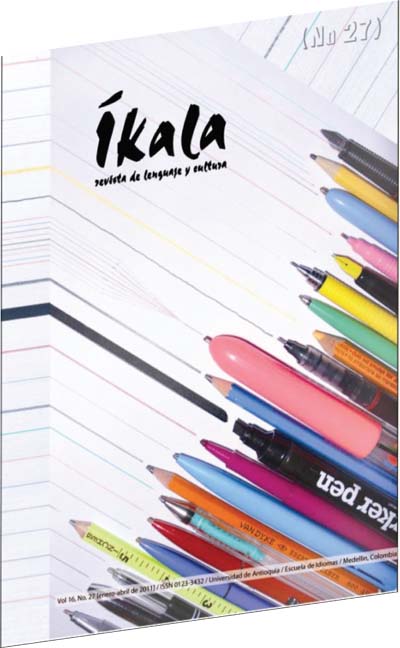Equivalence in the Translation of Phraseological Units. An Empirical
DOI:
https://doi.org/10.17533/udea.ikala.8657Keywords:
phraseological units, translation, equivalence, contrastive analysisAbstract
This article presents a contrastive analysis of the translation of a sample of phraseological units taken from the novel Rosario Tijeras and from its English version. Firstly, the elements affecting the equivalence in the translation of this kind of units are determined; secondly, each procedure used in the translation is identified; lastly, the degree of adequacy obtained is evaluated and the conclusions of the study are presented. The objectives included making a contrastive analysis which characterizes the type of equivalence achieved in the translation of the units in the corpus, identifying the kind of procedure used in the translation, evaluating the adequacy of the translation in each of the procedures used and proposing a method to evaluate the degree of adequacy in the translation of phraseological units. The method involved firstly, identifying the units in the source and target text and extracting them. Then, checking the phraseological status of the units against a series of lexicographic works and electronic corpora of reference, both in Spanish and English. The next step was determine the kind of semantic, morphosyntactic and pragmatic information that would characterize each unit and its English language counterpart to create the individual filing cards. This information was electronically stored in a lexicographic database, so it could be systematized and later analyzed. The results showed that loss or change of sense in the translation of phraseological units occurs when some components that make up the sense of the original units are not kept, when there is a wrong interpretation of the sense of the unit, or when the translator fails to recognize its presence. The procedures leading to this kind of loss have also been identified. On the other hand, some strategies have been identified which do not keep the elements that make up the sense of the unit, but which constitute appropriate translation equivalents in their context. The translation of phraseological units is particularly complex because with the procedures used it is not always possible to keep their pragmalinguistics and sociocultural components, which results in a significant loss of sense. Due to this complexity, some strategies and procedures for the translation of phraseological units should not be aprioristically considered as the most or least appropriate, and should only be evaluated in the context in which they are used. The results of this empirical study can be regarded as a method to evaluate the translation of phraseological units.
Downloads
References
Alvar Ezquerra, M. (1990). Vox. Gran diccionario general de la lengua española. Bogotá, Colombia: Rei Andes.
Baker, M. (1992). In Other Words. A Coursebook on Traslation. London, Inglaterra, y Nueva York, Estados Unidos, Routledge.
Casares, J. (1992) [1950]. Introducción a la lexicografía moderna. Madrid, España: Consejo Superior de Investigaciones Científicas (CSIC).
Castañeda N., L. S. y Henao S., J. I. (2001). El parlache. Medellín, Colombia: Universidad de Antioquia.
Castañeda N., L. S. y Henao S., J. I. (2006). Diccionario de parlache. Medellín, Colombia: La Carreta Editores.
Celis Albán, F. (2005). Diccionario de colombiano actual. Bogotá, Colombia: Intermedio editores.
Corpas, G. (1996). Manual de fraseología española. Madrid, España: Gredos.
Davie, M. Corpus del español. Brighman Young University. Recuperado de: http://www.corpusdelespanol.org//
Davie, M.Corpus of Contemporary American English. Brighman Young University. Recuperado de: http://www.americancorpus.org/
Delisle, J.,Lee-Jahnke, H. y Cornier, M. (1999). Terminologie de la traduction. En Delisle, J. (Ed.), Terminologie de la traduction (pp. 3-106). Amsterdam,
Holanda: John Benjamins B.V.
Dictionary.com (2009). Recuperado de: http://dictionary.reference.com Farlex, INC. (2009). The Free Dictionary. Recuperado de: http://www.thefreedictionary.com/
Franco, J. (2000). Rosario Tijeras. Bogotá, Colombia: Plaza & Janes.
Franco, J. (2004). Rosario Tijeras. Nueva York, Estados Unidos: Seven Stories Press. Traducción al inglés: Gregory Rabassa.
García C. y Muñoz, C. (1993). Diccionario de las hablas populares de Antioquia. Medellín, Colombia: Universidad de Antioquia.
García, C. (1991). Diccionario de locuciones del habla de Antioquia. Medellín, Colombia: Universidad de Antioquia.
García, C. y Muñoz, C. (1996). Refranero antioqueño. Diccionario fraseológico del habla antioqueña. Medellín, Colombia: Universidad de Antioquia.
García-Page, M. (2008). Introducción a la fraseología española. Estudio de las locuciones. Barcelona, España: Anthropos.
Grice, P. (1982). La lógica y la conversación. En: Lenguaje y sociedad (pp: 101-122). Cali: Traducciones Univalle.
Hurtado Albir, A. y Molina, L. (2002). Translation techniques revisited: A dynamic and functional approach. META, Journal de Traducteurs, 47 (4), 498-512.
Macmillan Publishers Limited (2009). Macmillan Dictionary. Recuperado de http://www.macmillandictionary.com/
Moliner, M. (1998). Diccionario de uso del español. Madrid, España: Gredos.
Montoya, R. (2006). Diccionario comentado del español actual en Colombia. Bogotá, Colombia: Párrafo.
Newmark, P. (1988). A Textbook of Translation. Nueva York, Estados Unidos: Prentice Hall.
Nida, E. (1974). The Theory and Practice of Translation. Amsterdam, Netherlands: United Bible Societies.
Nord, C. (1997). El error en la traducción: categorías y evaluación. En Hurtado Albir, A. (Ed.), La enseñanza de la traducción
(pp. 91-103). Castelló de la Plana, España: Universitat Jaume I
Nord, C. (2005). Text Analysis in Translation. Netherlands: Rodopi B.V.
Partridge, E. (2002). A Dictionary of Slang and Unconventional English. New York: Routledge.
Real Academia Española (2003). Diccionario de la lengua Española (DRAE). 22.a ed. Madrid, España: Espasa Calpe.
Recuperado de: http://www.rae.es/rae.html.
Real Academia Española. Corpus de referencia del español actual (CREA). Recuperado de: http://corpus.rae.es/creanet.html.
Ruiz Gurillo, L. (2001). Las locuciones en español actual. Madrid, España: Arco libros.
Seco, M., Andres, O. y Ramos, G. (2004). Diccionario fraseológico documentado del español actual: locuciones y modismos españoles. Madrid, España: Aguilar.
Tobón Betancourt, J. (1997). Colombianismos. Medellín, Colombia: Colección Autores Antioqueños.
University of Oxford. British National Corpus (BNC). Recuperado de: http://www.natcorp.ox.ac.uk/
Varela, F. y Kubarth, H. (1994). Diccionario fraseológico del español moderno. Madrid, España: Gredos.
Zuluaga, A. (1980). Introducción al estudio de las expresiones fijas. Frankfurt: Lang.
Zuluaga, A. (1998). Análisis y traducción de unidades fraseológicas desautomatizadas. Lingüística y Literatura, 34/35, 203-220.
Zuluaga, A. (2002). Los ''enlaces frecuentes'' de María Moliner. Observaciones sobre las llamadas colocaciones. PhiN, 22, 56-74. Recuperado el 20 de marzo de 2009, de http://www.phin.de












